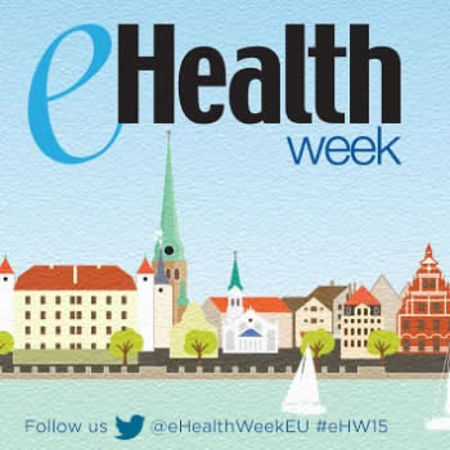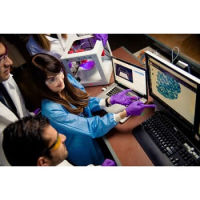eHealth is designated as one of Europe’s six “lead markets” for innovation in Europe. Taking place during the Latvian Presidency of the Council of the European Union, eHealth Week 2015 comprises of two main events: the High Level eHealth Conference organised by the Latvian Ministry of Health and the Latvian Presidency of the Council of the European Union and WoHIT (World of Health IT Conference & Exhibition) organised by HIMSS Europe.
This year there are more than 1200 delegates and 81 exhibitors from the 28 EU states representing public and private healthcare sectors, clinicians, hospital and IT managers. Day one included an EU SME eHealth Competition, sessions on Geographic Information Systems in Healthcare Analytics, Transcending Borders and Interoperability in Action plus a focus on EU Funded Projects.
Opening Ceremony
Officially launching the show, Dr.Guntis Belēvičs, Minister for Health of Latvia, Commissioner Vytenis Povilas Andriukaitis and H. Stephen Lieber, CAE President CEO of HIMSS took part in the "Me and my Health Transcending Borders” session, along with Toomas H.Ilves, President of the Republic of Estonia.
“Healthcare is lagging ten years behind when compared to other industries in implementing IT solutions,” the President said. “By implementing different IT solutions for both preventive healthcare and treatment services, we also improve the welfare of patients and the healthcare system in general.”
One of the highlights of the official opening ceremony was the celebration of IT Small and Medium Enterprises (SMEs) bringing innovation to healthcare and of European hospitals which have achieved HIMSS stage 6 and 7 status.
The eHealth Competition is an initiative that rewards the best eHealth/ mHealth solutions produced by SMEs. Its objective is to support business success of SMEs. There were 13 finalists presenting products and services that included a wrist tag for real time location of a person, a test for the early detection of Parkinson’s disease and mobile electronic observations, handover, task management and clinical assessments.
The overall winners were the German SOMA Smartphone app that enables employees to measure, analyse, and improve their stress levels on a scientifically-validated basis. UK-based Patient Knows Best controls records making integrated and empowered patient care a reality also took top place. “We’re thrilled and honoured to win,” the company told healthmanagement.org. “We’ve been working seven years for this.”
Stage 6 and 7 hospitals across Europe were also recognised by HIMSS. Radboud UMC was the third hospital in Europe to be given the Stage 7 EMR Adoption Model (EMRAM) award by HIMSS Europe while six further European institutions have received stage 6 validation.
GIS Making Sense of Data
Sessions started with ESRI putting Geographic Information Systems analytics in the spotlight and interestingly reminded us that this field has been around for millennia since Hippocrates made a study on the health characteristics of people who live in different topographical regions.
As presenter and Esri Chief Medical Officer and Director of Health Solutions Estelle Geraghty said, the issue the healthcare sector faces today is that the volumes of data being channelled through cyber space each day is the same quantity every 48 hours as what our forefathers gathered from the beginning of time until 2003!
How can GIS make data on everything from frequency of diabetes-related amputations to general lifestyle information improve the outcomes of healthcare? Time is money and perhaps nowhere is this clearer than in healthcare. Esri has gathered encouraging results on how GIS has helped save time across the sector board. Reducing waste of a healthcare facility’s financial resources is paramount in improving the health of each of us.
“One facility which we can’t name just yet is about to announce results on a framework for savings which will be jaw dropping,” Dr. Geraghty told healthmanagement.org. “This has been achieved through the application of GIS on the operational side of a hospital. For example, it costs $600 for every minute that a surgical procedure is delayed.” GIS is available via a computer desktop, embedded application and a GIS portal.
Interoperability in Action
The session “Interoperability in action: information + integration = innovation?” encouraged a lively debate on how rethinking interoperability standards and continuing education could bridge divides, change cultures, and open markets. Perspectives came from professionals across the eHealth spectrum. These included health management, industry, government, health education and standardisation. Described as ‘a call for action to explore how the partnership of HL7, EFMI and HIMSS can catalyse the equation “information + integration = innovation”’ there was a great deal of food for thought in this session.
Anne Moen, President of the European Federation of Medical Informatics spoke about the need to align the swift pace of IT development in healthcare with education of professions in the field. “IT education for health professionals is one of our biggest challenges,” she said.
John Hoyt, Executive Vice President, HIMSS Analytics in the US said that only 3.4% of hospitals in America or 250 out of 5000 were at Stage 7 level meaning completely paperless. Government legislation is in place to encourage more health facilities to reach Stage 7. “It’s government legislation which is actually working,” Hoyt told healthmanagement.org.
Of course innovation is the right hand of IT development in healthcare. Henrique Martins, President of Shared Services for the Ministry of Health in Portugal provided a fascinating insight into how key innovation is to the sector. “About half of our staff are under 25 and if we don’t produce something new every year we are in danger of losing them to industry. They see it as being sexy and where everything is happening.” That being said, Martins told healthmanagement.org that just 20 to 30% of new healthcare IT projects that passed through the Shared Services doors had ‘potential’.
Healthmanagement.org will continue to report on the ground from eHealth week in Riga. Watch this space!
Source: eHealth Week, Riga.
Image Credit: Worldofhealthit.org


























